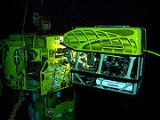
Remotely operated vehicle
Encyclopedia
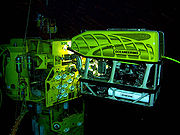
Offshore (hydrocarbons)
"Offshore", when used relative to hydrocarbons, refers to an oil, natural gas or condensate field that is under the sea, or to activities or operations carried out in relation to such a field...
. An ROV may sometimes be called a remotely operated underwater vehicle to distinguish it from remote control vehicle
Remote control vehicle
A remote control vehicle is defined as any mobile device that is controlled by a means that does not restrict its motion with an origin external to the device. This is often a radio control device, cable between control and vehicle, or an infrared controller...
s operating on land or in the air. ROVs are unoccupied, highly maneuverable and operated by a person aboard a vessel. They are linked to the ship by a tether
Tether
A tether is a cord, fixture, or signal that anchors something movable to a reference point which may be fixed or moving. There are a number of applications for tethers: balloons, kites, tethered wind-energy conversion systems, anchors, tethered water-flow energy conversion systems, towing, animal...
(sometimes referred to as an umbilical cable
Umbilical cable
An umbilical cable or umbilical is a cable which supplies required consumables to an apparatus. It is named by analogy with an umbilical cord...
), a group of cables that carry electrical power, video and data signals back and forth between the operator and the vehicle. High power applications will often use hydraulics in addition to electrical cabling. Most ROVs are equipped with at least a video camera and lights. Additional equipment is commonly added to expand the vehicle’s capabilities. These may include sonar
Sonar
Sonar is a technique that uses sound propagation to navigate, communicate with or detect other vessels...
s, magnetometer
Magnetometer
A magnetometer is a measuring instrument used to measure the strength or direction of a magnetic field either produced in the laboratory or existing in nature...
s, a still camera, a manipulator or cutting arm, water samplers, and instruments that measure water clarity, light penetration and temperature.
History
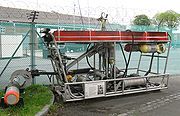
The US Navy funded most of the early ROV technology development in the 1960s into what was then named a "Cable-Controlled Underwater Recovery Vehicle" (CURV). This created the capability to perform deep-sea rescue operation and recover objects from the ocean floor, such as a nuclear bomb lost in the Mediterranean Sea
Mediterranean Sea
The Mediterranean Sea is a sea connected to the Atlantic Ocean surrounded by the Mediterranean region and almost completely enclosed by land: on the north by Anatolia and Europe, on the south by North Africa, and on the east by the Levant...
after the 1966 Palomares B-52 crash. Building on this technology base; the offshore oil & gas industry created the work class ROVs to assist in the development of offshore oil fields. More than a decade after they were first introduced, ROVs became essential in the 1980s when much of the new offshore development exceeded the reach of human divers. During the mid 1980s the marine ROV industry suffered from serious stagnation in technological development caused in part by a drop in the price of oil and a global economic recession. Since then, technological development in the ROV industry has accelerated and today ROVs perform numerous tasks in many fields. Their tasks range from simple inspection of subsea
Subsea
Subsea is a general term frequently used to refer to equipment, technology, and methods employed in marine biology, undersea geology, offshore oil and gas developments, underwater mining, and offshore wind power industries.- Oil and gas :...
structures, pipeline
Pipe (material)
A pipe is a tubular section or hollow cylinder, usually but not necessarily of circular cross-section, used mainly to convey substances which can flow — liquids and gases , slurries, powders, masses of small solids...
and platforms to connecting pipelines and placing underwater manifolds. They are used extensively both in the initial construction of a sub-sea development and the subsequent repair and maintenance.
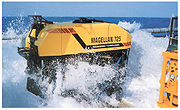
German battleship Bismarck
Bismarck was the first of two s built for the German Kriegsmarine during World War II. Named after Chancellor Otto von Bismarck, the primary force behind the German unification in 1871, the ship was laid down at the Blohm & Voss shipyard in Hamburg in July 1936 and launched nearly three years later...
, USS Yorktown
USS Yorktown (CV-5)
was an aircraft carrier commissioned in the United States Navy from 1937 until she was sunk at the Battle of Midway in June 1942. She was named after the Battle of Yorktown in 1781 and the lead ship of the Yorktown class which was designed after lessons learned from operations with the large...
, and SS Central America
SS Central America
SS Central America, sometimes called the Ship of Gold, was a 280-foot sidewheel steamer that operated between Central America and the eastern coast of the United States during the 1850s. She was originally named the SS George Law, after Mr. George Law of New York...
. In some cases, such as the SS Central America
SS Central America
SS Central America, sometimes called the Ship of Gold, was a 280-foot sidewheel steamer that operated between Central America and the eastern coast of the United States during the 1850s. She was originally named the SS George Law, after Mr. George Law of New York...
, ROVs have been used to recover material from the sea floor and bring it to the surface.
Much work remains to be done. More than half of the earth’s ocean is deeper than 3000 meters, which is the current working depth of most of the ROV technology. As of the writing of this article, the deeper half of the ocean has never been explored. This vast area has the potential to meet much of humanity’s needs for raw materials. As the industry advances to meet these challenges, we will undoubtedly see further improvements in these complicated robots.
While the oil & gas industry uses the majority of ROVs; other applications include science, military and salvage. Science usage is discussed below, the military uses ROV for tasks such as mine
Naval mine
A naval mine is a self-contained explosive device placed in water to destroy surface ships or submarines. Unlike depth charges, mines are deposited and left to wait until they are triggered by the approach of, or contact with, an enemy vessel...
clearing and inspection. Approximately a dozen times per year ROVs are used in marine salvage
Marine salvage
Marine salvage is the process of rescuing a ship, its cargo, or other property from peril. Salvage encompasses rescue towing, refloating a sunken or grounded vessel, or patching or repairing a ship...
operations of downed planes and sunken ships.
Construction
Conventional R.O.V.s are built with a large flotation pack on top of an aluminium chassisChassis
A chassis consists of an internal framework that supports a man-made object. It is analogous to an animal's skeleton. An example of a chassis is the underpart of a motor vehicle, consisting of the frame with the wheels and machinery.- Vehicles :In the case of vehicles, the term chassis means the...
, to provide the necessary buoyancy
Buoyancy
In physics, buoyancy is a force exerted by a fluid that opposes an object's weight. In a column of fluid, pressure increases with depth as a result of the weight of the overlying fluid. Thus a column of fluid, or an object submerged in the fluid, experiences greater pressure at the bottom of the...
. Syntactic foam
Syntactic foam
Syntactic foams are composite materials synthesized by filling a metal, polymer or ceramic matrix with hollow particles called microballoons, "syntactic" meaning "put together"...
is often used for the flotation. A tool sled may be fitted at the bottom of the system and can accommodate a variety of sensors. By placing the light components on the top and the heavy components on the bottom, the overall system has a large separation between the center of buoyancy and the center of gravity
Center of gravity
In physics, a center of gravity of a material body is a point that may be used for a summary description of gravitational interactions. In a uniform gravitational field, the center of mass serves as the center of gravity...
: this provides stability and the stiffness to do work underwater.
Electrical cables may be run inside oil-filled tubing to protect them from corrosion in seawater. Thrusters are usually in all three axes to provide full control. Camera
Camera
A camera is a device that records and stores images. These images may be still photographs or moving images such as videos or movies. The term camera comes from the camera obscura , an early mechanism for projecting images...
s, lights and manipulator
Manipulator
In robotics a manipulator is a device used to manipulate materials without direct contact. The applications were originally for dealing with radioactive or biohazardous materials, using robotic arms, or they were used in inaccessible places. In more recent developments they have been used in...
s are on the front of the ROV or occasionally in the rear to help in maneuvering.
The majority of the work class ROVs are built as described above; however, this is not the only style in ROV building. Specifically, the smaller ROVs can have very different designs, each geared towards its own task.
Military ROV
In October 2008 the U.S. Navy began to replace its manned rescue systems, based on the Mystic DSRVDSRV-1 Mystic
DSRV-1 Mystic is a Deep Submergence Rescue Vehicle that is rated to dive up to 1500 metres. DSRV1 was built by Lockheed for the U.S. Navy and launched 24 January 1970....
and support craft, with a modular system, the SRDRS based on a tethered, unmanned ROV called a pressurized rescue module (PRM). This followed years of tests and exercises with submarines from the fleets of several nations.
The US Navy also uses an ROV called AN/SLQ-48 Mine Neutralisation Vehicle (MNV) for mine warfare
Naval mine
A naval mine is a self-contained explosive device placed in water to destroy surface ships or submarines. Unlike depth charges, mines are deposited and left to wait until they are triggered by the approach of, or contact with, an enemy vessel...
. It can go 1000 yards away from the ship, and can reach 2000 feet deep. The mission packages available for the MNV are known as MP1, MP2, and MP3.
- The MP1 is a cable cutter to surface the moored mine for recovery exploitation or EOD detonation.
- The MP2 is a bomblet of 75 lb PBXPolymer-bonded explosiveA polymer-bonded explosive, also called PBX or plastic-bonded explosive, is an explosive material in which explosive powder is bound together in a matrix using small quantities of a synthetic polymer...
N-103 high explosive for neutralising bottom/ground mines. - The MP3 is a moored mine cable gripper and a float with the MP2 bomblet combination to neutralise moored mines underwater.
The charges are detonated by acoustic signal from the ship.
The AN/BLQ-11 autonomous Unmanned Undersea Vehicle (UUV)
Long-Term Mine Reconnaissance System
The AN/BLQ-11 autonomous Unmanned Undersea Vehicle is a torpedo tube-launched and tube-recovered underwater search and survey unmanned undersea vehicle capable of performing autonomous minefield reconnaissance as much as in advance of a host Los Angeles-, Seawolf-, or Virginia-class...
is designed for covert mine countermeasure capability and can be launched from certain submarines.
The ROVs are only on Avenger class mine countermeasures ship
Avenger class mine countermeasures ship
Avenger-class mine countermeasures ships are a class of 14 ships constructed by the United States Navy 1987–1994. The ships are designed to clear mines from vital waterways. The ships have the hull designator MCM.-Background:In the early 1980s, the U.S...
s. There are 14 ships, operating mostly off the coast of Japan and California, and there are always four US minesweepers in the Persian Gulf
Persian Gulf
The Persian Gulf, in Southwest Asia, is an extension of the Indian Ocean located between Iran and the Arabian Peninsula.The Persian Gulf was the focus of the 1980–1988 Iran-Iraq War, in which each side attacked the other's oil tankers...
: USS Ardent (MCM-12)
USS Ardent (MCM-12)
The third USS Ardent is an Avenger-class mine countermeasures ship in the United States Navy.She was built by Peterson Shipbuilders, Sturgeon Bay, Wisconsin. Ardent is homeported at Bahrain and is part of the U.S...
, USS Dextrous (MCM-13)
USS Dextrous (MCM-13)
USS Dextrous is an Avenger-class mine countermeasures ship in the United States Navy.She was built by Peterson Shipbuilders, Sturgeon Bay, Wisconsin. Dextrous is homeported in Bahrain and is part of the U.S...
, USS Scout (MCM-8)
USS Scout (MCM-8)
The fourth USS Scout is an Avenger-class mine countermeasures ship in the service of the United States Navy.-Service history:Scout was laid down on 8 June 1987 at Peterson Builders in Sturgeon Bay, Wisconsin...
and USS Gladiator (MCM-11)
USS Gladiator (MCM-11)
USS Gladiator , an Avenger-class mine countermeasures ship, is the third U.S. Navy ship of that name.The ship was featured in Mega Movers when it was transported to Bahrain on top of a heavy lift ship.-External links:*****...
.
During August 19, 2011, a Boeing
Boeing
The Boeing Company is an American multinational aerospace and defense corporation, founded in 1916 by William E. Boeing in Seattle, Washington. Boeing has expanded over the years, merging with McDonnell Douglas in 1997. Boeing Corporate headquarters has been in Chicago, Illinois since 2001...
-made robotic submarine dubbed Echo Ranger
Echo Ranger
The Echo Ranger is a marine remotely operated vehicle built by Boeing. Originally built in 2001 to capture high-resolution sonar images of sea beds for the oil and gas industry , the Echo Ranger has been undergoing testing for possible use by the military...
was being tested for possible use by the U.S. military to stalk enemy waters, patrol local harbors for national security threats and scour ocean floors to detect environmental hazards.
Science ROVs
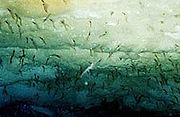
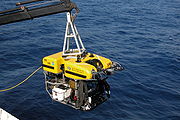
Jellyfish
Jellyfish are free-swimming members of the phylum Cnidaria. Medusa is another word for jellyfish, and refers to any free-swimming jellyfish stages in the phylum Cnidaria...
Bumpy
Bumpy
Bumpy is a species of Jellyfish, Stellamedusa ventana.The species was first described in the Journal of the Marine Biological Association in 2004 by Kevin Raskoff and George Matsumoto of the Monterey Bay Aquarium Research Institute. As of February 2004, seven specimens have been observed, five off...
and the eel-like halosaur
Halosaur
Halosaurs are eel-shaped fishes found only at great ocean depths. As the family Halosauridae, halosaurs are one of two families within the order Notacanthiformes; the other being the deep-sea spiny eels. Halosaurs are thought to have a worldwide distribution, with some seventeen species in three...
s. In the USA, cutting edge work is done at several public and private oceanographic institutions, including the Monterey Bay Aquarium Research Institute
Monterey Bay Aquarium Research Institute
The Monterey Bay Aquarium Research Institute is a not-for-profit oceanographic research center in Moss Landing, California affiliated with the Monterey Bay Aquarium. It was founded in 1987 by David Packard of Hewlett-Packard fame...
(MBARI), the Woods Hole Oceanographic Institution
Woods Hole Oceanographic Institution
The Woods Hole Oceanographic Institution is a private, nonprofit research and higher education facility dedicated to the study of all aspects of marine science and engineering and to the education of marine researchers. Established in 1930, it is the largest independent oceanographic research...
(WHOI) (with Nereus
Nereus (underwater vehicle)
Nereus is a hybrid autonomous underwater vehicle built by the Woods Hole Oceanographic Institution . Constructed as a research vehicle to operate at depths of up to , it was designed to explore Challenger Deep, the deepest surveyed point in the global ocean...
) , and the University of Rhode Island
University of Rhode Island
The University of Rhode Island is the principal public research university in the U.S. state of Rhode Island. Its main campus is located in Kingston. Additional campuses include the Feinstein Campus in Providence, the Narragansett Bay Campus in Narragansett, and the W. Alton Jones Campus in West...
/ Institute for Exploration
Mystic Aquarium & Institute for Exploration
The Mystic Aquarium & Institute for Exploration is an aquarium and oceanography institute in Mystic, Connecticut. The Aquarium is one of only four U.S. facilities nation where people can see Steller sea lions and has one of the largest outdoor Beluga Whale exhibits in the United States. It is also...
(URI/IFE). The picture to the right shows the behavior and microdistribution of krill under the ice of Antarctica.
Science ROVs take many shapes and sizes. Since good video footage is a core component of most deep-sea scientific research, research ROVs tend to be outfitted with high-output lighting systems and broadcast quality cameras. Depending on the research being conducted, a science ROV will be equipped with various sampling devices and sensors. Many of these devices are one-of-a-kind, state-of-the-art experimental components that have been configured to work in the extreme environment of the deep ocean. Science ROVs also incorporate a good deal of technology that has been developed for the commercial ROV sector, such as hydraulic manipulators and highly accurate subsea navigation systems.
While there are many interesting and unique science ROVs, there are a few larger high-end systems that are worth taking a look at. MBARI's Tiburon vehicle cost over $6 million US dollars to develop and is used primarily for midwater and hydrothermal research on the West Coast of the US. WHOI's Jason system has made many significant contributions to deep-sea oceanographic research and continues to work all over the globe. URI/IFE's Hercules ROV is one of the first science ROVs to fully incorporate a hydraulic propulsion system and is uniquely outfitted to survey and excavate ancient and modern shipwrecks. The Canadian Scientific Submersible Facility ROPOS system is continually used by several leading ocean sciences institutions and universities for challenging tasks such as deep-sea vents recovery and exploration to the maintenance and deployment of ocean observatories.
Educational Outreach ROVs
The SeaPerchSeaPerch
The SeaPerch Remotely Operated Vehicle educational program was inspired by the 1997 book, , by Harry Bohm and Vickie Jensen. A SeaPerch is an educational tool and kit that allows elementary, middle, and high-school students to construct a simple, remotely-operated underwater vehicle, or Remotely...
Remotely Operated Underwater Vehicle (ROV) educational program is an educational tool and kit that allows elementary, middle, and high-school students to construct a simple, remotely operated underwater vehicle, from polyvinyl chloride
Polyvinyl chloride
Polyvinyl chloride, commonly abbreviated PVC, is a thermoplastic polymer. It is a vinyl polymer constructed of repeating vinyl groups having one hydrogen replaced by chloride. Polyvinyl chloride is the third most widely produced plastic, after polyethylene and polypropylene. PVC is widely used in...
(PVC) pipe and other readily made materials. The SeaPerch program teaches students basic skills in ship and submarine design and encourages students to explore naval architecture
Naval architecture
Naval architecture is an engineering discipline dealing with the design, construction, maintenance and operation of marine vessels and structures. Naval architecture involves basic and applied research, design, development, design evaluation and calculations during all stages of the life of a...
and marine and ocean engineering
Offshore construction
Offshore construction is the installation of structures and facilities in a marine environment, usually for the production and transmission of electricity, oil, gas and other resources....
concepts. SeaPerch is sponsored by the Office of Naval Research
Office of Naval Research
The Office of Naval Research , headquartered in Arlington, Virginia , is the office within the United States Department of the Navy that coordinates, executes, and promotes the science and technology programs of the U.S...
, as part of the National Naval Responsibility for Naval Engineering (NNRNE), and the program is managed by the Society of Naval Architects and Marine Engineers
Society of Naval Architects and Marine Engineers
The Society of Naval Architects and Marine Engineers is a professional society that provides a forum for the advancement of the engineering profession as applied to the marine field...
.
The Marine Advanced Technology Education (MATE) Center uses ROVs to teach middle school, high school, community college, and university students about ocean-related careers and help them improve their science, technology, engineering, and math skills. MATE’s annual student ROV competition challenges student teams from all over the world to compete with ROVs that they design and build. The competition uses realistic ROV-based missions that simulate a high-performance workplace environment, focusing on a different theme that exposes students to many different aspects of marine-related technical skills and occupations. The ROV competition is organized by MATE and the Marine Technology Society's ROV Committee and funded by organizations such as the National Aeronautics and Space Administration (NASA), National Oceanic and Atmospheric Administration
National Oceanic and Atmospheric Administration
The National Oceanic and Atmospheric Administration , pronounced , like "noah", is a scientific agency within the United States Department of Commerce focused on the conditions of the oceans and the atmosphere...
(NOAA), and Oceaneering, and many other organizations that recognize the value of highly trained students with technology skills such as ROV designing, engineering, and piloting. MATE was established with funding from the National Science Foundation
National Science Foundation
The National Science Foundation is a United States government agency that supports fundamental research and education in all the non-medical fields of science and engineering. Its medical counterpart is the National Institutes of Health...
and is headquartered at Monterey Peninsula College
Monterey Peninsula College
Monterey Peninsula College commonly called MPC is a public community college located in Monterey, California. Established in 1947, it is a part of the California Community Colleges system.-External links:*...
in Monterey, California.
Hobby ROVs
With an increased interest in the ocean by many people, both young and old, and the increased availability of once expensive and non-commercially available equipment, ROVs have become a popular hobby amongst many. This hobby involves the construction of small ROVs that generally are made out of PVC piping and often can dive to depths between 50 to 100 feet but some have managed to get to 300 feet. This new interest in ROVs has led to the formation of many competitions, including MATE (Marine Academy of Technology and Environmental Science) and NURC (National Underwater Robotics Challenge). These are competitions in which competitors, most commonly schools and other organizations, compete against each other in a series of tasks using ROVs that they have built.Most hobby ROVs are tested in lakes where the water is calm, however some have tested their own personal ROVs in the sea. Doing so, however, creates many difficulties due to waves and currents that can cause the ROV to stray off course or struggle to push through the surf due to the small size of engines that are fitted to most hobby ROVs.
Classification
Submersible ROVs are normally classified into categories based on their size, weight, ability or power. Some common ratings are:- Micro - typically Micro class ROVs are very small in size and weight. Today’s Micro Class ROVs can weigh less than 3 kg. These ROVs are used as an alternative to a diver, specifically in places where a diver might not be able to physically enter such as a sewer, pipeline or small cavity.
- Mini - typically Mini Class ROVs weigh in around 15 kg. Mini Class ROVs are also used as a diver alternative. One person may be able to transport the complete ROV system out with them on a small boat, deploy it and complete the job without outside help. Occasionally both Micro and Mini classes are referred to as "eyeball" class to differentiate them from ROVs that may be able to perform intervention tasks.
- General - typically less than 5 HPHorsepowerHorsepower is the name of several units of measurement of power. The most common definitions equal between 735.5 and 750 watts.Horsepower was originally defined to compare the output of steam engines with the power of draft horses in continuous operation. The unit was widely adopted to measure the...
(propulsion); occasionally small three finger manipulators grippers have been installed, such as on the very early RCV 225. These ROVUs may be able to carry a sonarSonarSonar is a technique that uses sound propagation to navigate, communicate with or detect other vessels...
unit and are usually used on light survey applications. Typically the maximum working depth is less than 1,000 metres though one has been developed to go as deep as 7,000 m. - Light Workclass - typically less than 50 hp (propulsion). These ROVs may be able to carry some manipulators. Their chassis may be made from polymers such as polyethylenePolyethylenePolyethylene or polythene is the most widely used plastic, with an annual production of approximately 80 million metric tons...
rather than the conventional stainless steel or aluminium alloys. They typically have a maximum working depth less than 2000 m. - Heavy Workclass - typically less than 220 hp (propulsion) with an ability to carry at least two manipulators. They have a working depth up to 3500 m.
- Trenching/Burial - typically more than 200 hp (propulsion) and not usually greater than 500 hp (while some do exceed that) with an ability to carry a cable laying sled and work at depths up to 6000 m in some cases.
Submersible ROVs may be "free swimming" where they operate neutrally buoyant on a tether from the launch ship or platform, or they may be "garaged" where they operate from a submersible "garage" or "tophat" on a tether attached to the heavy garage that is lowered from the ship or platform. Both techniques have their pros and cons; however very deep work is normally done with a garage.
Naming conventions
ROVs that are manufactured following a standardized design are commonly named by a brand name followed by a number indicating the order of manufacture. Examples would be Sealion 1 or Scorpio 17. The design of a series of ROVs may have changed significantly over the life of an ROV series, however an ROV pilot will often be familiar with the idiosyncrasies of a particular vehicle by name.ROVs that are one-off or unique designs may be given a unique name similar to the style used for ships. ROVs are not normally referred to in the female gender as ships may be, but by gender-neutral pronouns or 'neuter words'.
See also
- Autonomous underwater vehicleAutonomous Underwater VehicleAn autonomous underwater vehicle is a robot which travels underwater without requiring input from an operator. AUVs constitute part of a larger group of undersea systems known as unmanned underwater vehicles, a classification that includes non-autonomous remotely operated underwater vehicles...
- Echo RangerEcho RangerThe Echo Ranger is a marine remotely operated vehicle built by Boeing. Originally built in 2001 to capture high-resolution sonar images of sea beds for the oil and gas industry , the Echo Ranger has been undergoing testing for possible use by the military...
- Global Explorer ROVGlobal Explorer ROVGlobal Explorer ROV is a unique deep water remotely operated vehicle that has made numerous dives below 9,000' on science and survey expeditions for National Geographic, NOAA and other important research organizations...
- Nereus (underwater vehicle)Nereus (underwater vehicle)Nereus is a hybrid autonomous underwater vehicle built by the Woods Hole Oceanographic Institution . Constructed as a research vehicle to operate at depths of up to , it was designed to explore Challenger Deep, the deepest surveyed point in the global ocean...
- PantheROVPantheROVPantheROV is the name of the remotely operated vehicle built by undergraduate students at the University of Wisconsin–Milwaukee for the annual MATE , essentially an underwater robotics competition. PantheROV is a conjugation of UWMs mascot, the panther, and ROV. The is generously supported by...
- Scorpio ROVScorpio ROVThe Scorpio [Submersible Craft for Ocean Repair, Position, Inspection and Observation] is a brand of underwater submersible Remotely Operated Vehicle manufactured by Perry Tritech used by subsea industries such as the oil industry for general operations, and also by the United States Navy and...
- SubseaSubseaSubsea is a general term frequently used to refer to equipment, technology, and methods employed in marine biology, undersea geology, offshore oil and gas developments, underwater mining, and offshore wind power industries.- Oil and gas :...
- Underwater Acoustic Positioning SystemUnderwater Acoustic Positioning SystemAn underwater acoustic positioning system is a system for the tracking and navigation of underwater vehicles or divers by means of acoustic distance and/or direction measurements, and subsequent position triangulation...
- UNESCO Convention on the Protection of the Underwater Cultural HeritageUNESCO Convention on the Protection of the Underwater Cultural HeritageThe UNESCO Convention on the Protection of the Underwater Cultural Heritage, adopted by the UNESCO General Conference on 2 November 2001 is an international treaty aimed at saving the underwater cultural heritage....
- VideoRayVideoRayThe VideoRay is a micro underwater submersible remotely operated vehicle . The 8-pound ROV is operated from a suitcase sized control panel and provides crisp video footage to the user...
External links
- The SERPENT project (Scientific and Environmental ROV Partnership using iNdustrial Technology)
- Build your own ROV
- ROV Committee of the Marine Technology Society
- Remotely Operated Vehicles (ROV), Ocean ExplorerOffice of Ocean ExplorationIn the United States the Office of Ocean Exploration is a division of the National Oceanic and Atmospheric Administration run under the auspices of the Office of Oceanic and Atmospheric Research ....
, NOAA - What are Remotely Operated Vehicles (ROVs)?
- How do you build your own ROV?
- ROV-online.com | A resource for those interested in ROV, AUV, and robotics in general
- ROVs at the Smithsonian Ocean Portal

